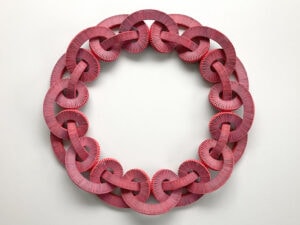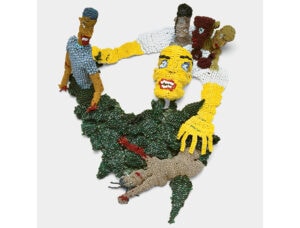Exhibition in Motion: Objects Performed took place at the Bellevue Arts Museum in Bellevue, Washington on the evening of May 28, 2011, in conjunction with the Society of North American Goldsmiths (SNAG) conference. Objects Performed was a marked shift in the format of SNAG’s annual exhibition in motion, from a runway fashion show to an extemporaneous dance performance. The 40 minute performance was curated by Venetia Dale and Tia Kramer, choreographed by Amelia Reeber and featured the work of 25 artists and ten professional dancers.
The number of people and entities that came together to realize the work made Objects Performed necessarily experimental. In the performance, the choreographic vision of Amelia Reeber could be felt most strongly, especially in the decisions to make the performance improvisational and to only allow the dancers to see the objects for the first time at the performance itself. From the outset – with the cartoonish boinging sound of springs and suspenseful horror strings – the musical soundscape played a central role in governing the movement of the performers. The tempo, tone, timbre and emotive quality of the sound became an under-billed yet crucial third pillar of the work along with the dancers and objects. The soundscape had clear stylistic divisions, marked by silence for several moments. Each time the music stopped and returned it announced a new act and direction in the work.
The performance could be characterized by its repeating themes. First among these were the crisply executed gestures by a focal dancer that slowly built through the ensemble until as many as eight dancers echoed the original movement. Often, there were two or three distinct groups interacting with separate objects creating a call and response within and among the groups. Some of the most successful moments of the performance took place as two performers negotiated an object as if trying to figure out its proper mode of use. It was the natural history museum vignette of man making fire, inventing the wheel or tying stick to stone. It was primal, intuitive and powerful. The clues embedded in the objects themselves facilitated their performative use but the conclusions were reached only with attention and contemplation.
The action built slowly towards the audience from the back of the stage onto the floor and eventually right on top of the first row. Once the space was fully explored, multiple focal points developed, making for a disjunctive visual experience that was only heightened by the musical score.
Craft media, including jewelry, with its history of marginalization certainly does not like to be suppressed by any other artistic mode, even if it is an invited partner. However, this was the reality of this particular collaboration. The decision by the curators and choreographer to present an extemporaneous work meant that the objects would only receive passing consideration, rather than careful and intentional reverence. Ultimately, the decision to place the dancers’s intention at the center of the work presented a proposition to the insider audience; to consider their work as capable of being supplemental, rather than an artistic end in and of itself. Even if a distasteful proposition to some, it is notable for its divergence from the party line.
For a medium and a field that is desperately seeking strategies to project itself into the future, Exhibition in Motion: Objects Performed was a compelling proposition. It was a credible effort that opened new avenues for exploration and therein lies the true achievement of the work. One can only hope that there will be future works to follow this one and that lessons will be learned from this event’s shortcomings and logistical failures.





